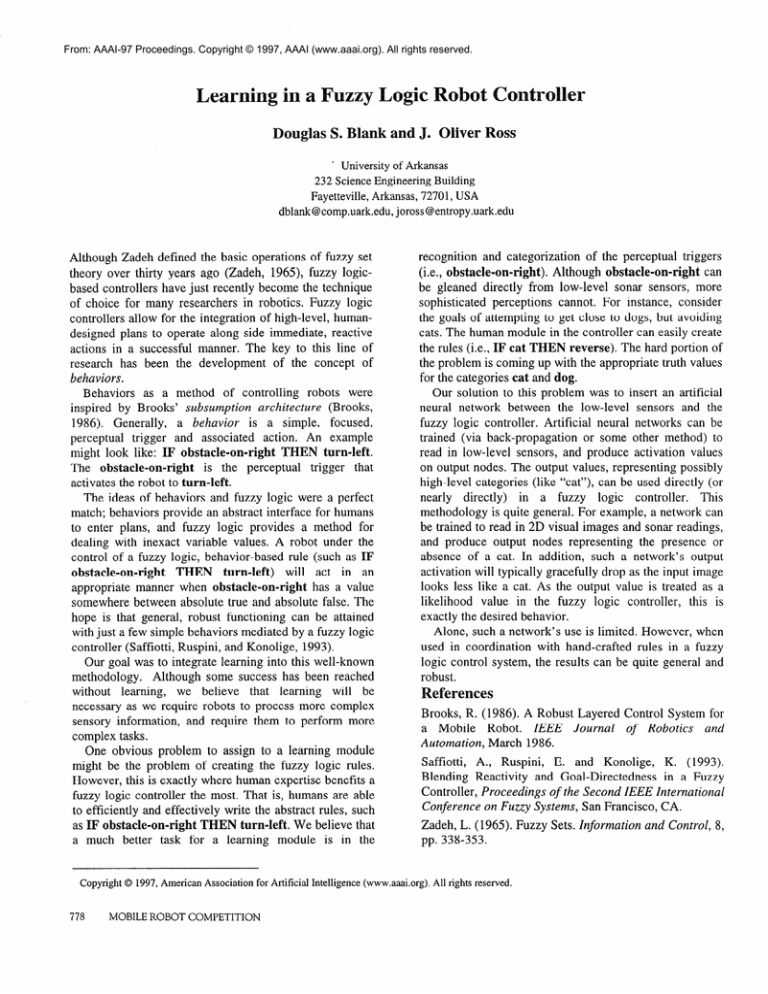
From: AAAI-97 Proceedings. Copyright © 1997, AAAI (www.aaai.org). All rights reserved.
Douglas S. Blank and J. Oliver Ross
’ University of Arkansas
232 Science Engineering Building
Fayetteville, Arkansas, 72701, USA
dblank@comp.uark.edu,
joross@entropy.uark.edu
Although Zadeh defined the basic operations of fuzzy set
theory over thirty years ago (Zadeh, 1965), fuzzy logicbased controllers have just recently become the technique
of choice for many researchers in robotics. Fuzzy logic
controllers allow for the integration of high-level, humandesigned plans to operate along side immediate, reactive
actions in a successful manner. The key to this line of
research has been the development
of the concept of
behaviors.
Behaviors as a method of controlling
robots were
inspired by Brooks’ subsumption architecture (Brooks,
1986). Generally,
a behavior
is a simple, focused,
perceptual trigger and associated action. An example
might look like: IF obstacle-on-right
THEN turn-left.
The obstacle-on-right
is the perceptual
trigger that
activates the robot to turn-left.
The ideas of behaviors and fuzzy logic were a perfect
match; behaviors provide an abstract interface for humans
to enter plans, and fuzzy logic provides a method for
dealing with inexact variable values. A robot under the
control of a fuzzy logic, behavior-based
rule (such as IF
obstacle-on-right
THEN
turn-left)
will act in an
appropriate manner when obstacle-on-right
has a value
somewhere between absolute true and absolute false. The
hope is that general, robust functioning can be attained
with just a few simple behaviors mediated by a fuzzy logic
controller (Saffiotti, Ruspini, and Konolige, 1993).
Our goal was to integrate learning into this well-known
methodology.
Although some success has been reached
we believe that learning
will be
without learning,
necessary as we require robots to process more complex
sensory information, and require them to perform more
complex tasks.
One obvious problem to assign to a learning module
might be the problem of creating the fuzzy logic rules.
However, this is exactly where human expertise benefits a
fuzzy logic controller the most. That is, humans are able
to efficiently and effectively write the abstract rules, such
as IF obstacle-on-right
THEN turn-left. We believe that
a much better task for a learning module is in the
Copyright
778
0 1997, American
Association
MOBILE ROBOT COMPETITION
for Artificial
Intelligence
recognition and categorization of the perceptual triggers
(i.e., obstacle-on-right).
Although obstacle-on-right
can
be gleaned directly from low-level sonar sensors, more
sophisticated perceptions cannot. For instance, consider
the goals of attempting to get close to dogs, but avoiding
cats. The human module in the controller can easily create
the rules (i.e., IF cat THEN reverse). The hard portion of
the problem is coming up with the appropriate truth values
for the categories cat and dog.
Our solution to this problem was to insert an artificial
neural network between the low-level sensors and the
fuzzy logic controller. Artificial neural networks can be
trained (via back-propagation
or some other method) to
read in low-level sensors, and produce activation values
on output nodes. The output values, representing possibly
high-level categories (like “cat”), can be used directly (or
nearly directly)
in a fuzzy logic controller.
This
methodology is quite general. For example, a network can
be trained to read in 2D visual images and sonar readings,
and produce output nodes representing the presence or
absence of a cat. In addition, such a network’s output
activation will typically gracefully drop as the input image
looks less like a cat. As the output value is treated as a
likelihood value in the fuzzy logic controller, this is
exactly the desired behavior.
Alone, such a network’s use is limited. However, when
used in coordination with hand-crafted rules in a fuzzy
logic control system, the results can be quite general and
robust.
(www.aaai.org).
References
Brooks, R. (1986). A Robust Layered Control System for
a Mobile
Robot. IEEE Journal
of Robotics
and
Automation, March 1986.
Saffiotti, A., Ruspini, E. and Konolige,
K. (1993).
Blending Reactivity and Goal-Directedness
in a Fuzzy
Controller, Proceedings of the Second IEEE International
Conference on Fuzzy Systems, San Francisco, CA.
Zadeh, L. (1965). Fuzzy Sets. Information
pp. 338-353.
All rights reserved.
and Control, 8,


